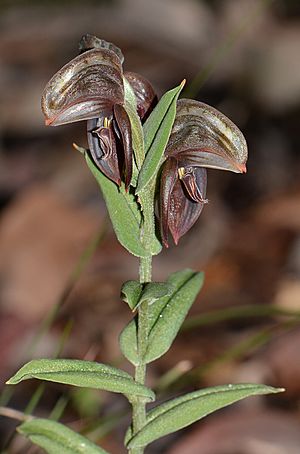Pouched greenhood facts for kids
Quick facts for kids Pouched greenhood |
|
|---|---|
 |
|
| Pterostylis concave growing near Wandering | |
| Scientific classification | |
| Genus: |
Pterostylis
|
| Species: |
concava
|
| Synonyms | |
|
|
The Pterostylis concava, often called the pouched greenhood or cupped banded greenhood, is a fascinating plant. It is part of the amazing orchid family. This special orchid grows only in the south-west region of Western Australia.
When it's not flowering, the plant has a group of leaves shaped like a circle, called a rosette. When it's ready to bloom, it grows a tall stem with up to ten or more flowers. These flowers are usually dark reddish-brown, but can also be green and white. They have unique, deeply cupped parts called lateral sepals. The pouched greenhood is not very common. You can mostly find it between the towns of Bindoon and Mount Barker.
Contents
What Does the Pouched Greenhood Look Like?
The pouched greenhood, or Pterostylis concava, is a plant that grows from an underground tuber. This means it has a special storage part underground, like a small potato. It is a perennial herb, so it lives for more than two years. It is also deciduous, meaning its leaves fall off during certain seasons.
Leaves and Stems
When the plant is not flowering, it has a rosette of leaves. This is a circular cluster of leaves close to the ground. There are usually four to eight leaves in this rosette. Each leaf is about 6 to 30 millimeters (0.2 to 1.2 inches) long. They are also about 5 to 15 millimeters (0.2 to 0.6 inches) wide. These leaves grow on a short stem, about 10 to 15 millimeters (0.4 to 0.6 inches) tall.
When the plant flowers, it grows a tall spike. This spike can be 100 to 450 millimeters (4 to 18 inches) high. It has between three and nine leaves along its stem. These stem leaves are 14 to 40 millimeters (0.6 to 1.6 inches) long. They are also 4 to 7 millimeters (0.2 to 0.3 inches) wide.
Flowers
The flowers of the pouched greenhood are quite striking. They are usually dark reddish-brown. Sometimes they can be green, or a mix of green and white. Each flower is about 20 to 25 millimeters (0.8 to 1.0 inches) long. They are also about 12 to 15 millimeters (0.5 to 0.6 inches) wide.
The top part of the flower is called the "galea." This hood is formed by the dorsal sepal and the petals joining together. It covers the central part of the flower. The two side sepals point downwards and are deeply curved, like a dish. These lateral sepals are 17 to 20 millimeters (0.7 to 0.8 inches) long. They are also 18 to 22 millimeters (0.7 to 0.9 inches) wide and are joined at their base.
The labellum is a special part of the orchid flower. For the pouched greenhood, it is dark brown and looks a bit like an insect. It is about 7 millimeters (0.3 inches) long and 4 millimeters (0.2 inches) wide. This labellum can flick upwards if something touches it. You can see these unique flowers from June to early September.
How the Pouched Greenhood Got Its Name
The scientific name Pterostylis concava was first officially described in 1989. Two botanists, David Jones and Mark Clements, gave it this name. They published their description in a scientific paper called Australian Orchid Research. The plant they studied came from an area between Boyup Brook and Cranbrook.
The second part of its name, concava, is a Latin word. It means "hollowed" or "arched inward." This name was chosen because of the deeply dished, or hollowed, shape of the lateral sepals on the flower.
Where the Pouched Greenhood Lives
The pouched greenhood prefers to grow in woodlands and forests. It usually likes places that are moist and sheltered from strong winds. You can find it mainly between Bindoon and Mount Barker in Western Australia. There is also a separate group of these orchids living further east, near Esperance.
This orchid grows in several different natural areas. These include the Avon Wheatbelt, Esperance Plains, Jarrah Forest, Swan Coastal Plain, and Warren biogeographic regions.
Conservation Status
The Government of Western Australia's Department of Parks and Wildlife has looked at the pouched greenhood. They have classified Pterostylis concava as "not threatened." This means it is not currently at risk of disappearing.

